Control Strategy and Corresponding Parameter Analysis of a Virtual Synchronous Generator Considering Frequency Stability of Wind Power Grid-Connected System
Abstract
:1. Introduction
2. Mathematical Modeling of DFIG and IFLVSG Control Strategy
2.1. Mathematical Model of the DFIG
2.2. Mathematical Model of the VSG Control Strategy
2.3. Mathematical Model of the IFLVSG Control Strategy
3. Analysis of IFLVSG Control Strategy
3.1. Control Structure of a DFIG-IFLVSG Grid-Connected System
3.2. Control Principle of IFL
3.2.1. and Based on the Bang-Bang Control Strategy
3.2.2. Arctangent and
3.2.3. Exponential and
4. Sensitivity Analysis of Control Parameters and Its Influence on Frequency Stability
4.1. Small-Signal Model of the DFIG-IFLVSG Grid-Connected System
4.2. Sensitivity of Each Control Parameter in the DFIG-IFLVSG Grid-Connected System
4.3. Analysis of the Advantages of Exponential and
4.4. Influence of Control Parameters on System Frequency Stability in the DFIG-IFLVSG Grid-Connected System
4.4.1. The Effect of the Control Parameter M3 on the Frequency Stability of the System
4.4.2. The Effect of the Control Parameter on the Frequency Stability of the System
4.4.3. The Effect of the Control Parameter on the Frequency Stability of the System
4.4.4. The Effect of the Control Parameter on the Frequency Stability of the System
5. Experimental Results
5.1. Superiority Verification of the IFLVSG Control Strategy
5.2. Verification and Analysis on the Influence Laws of the Change of the Main Control Parameters on the System
6. Conclusions
- The advantage of the exponential IFLVSG control strategy is clarified by the sensitivity calculation method. To better improve the stability of the wind power grid-connected system, three typical IFLVSG control strategies are studied. According to the variable range of and , and the sensitivity of the system frequency stability to the change of control parameters in the IFL, the advantages of the exponential IFLVSG control strategy are highlighted;
- Rely on the sensitivity calculation method to improve the analysis efficiency. According to the sensitivity calculation method, all parameters in the state space equation, including the IFLVSG control strategy, are calculated. While it is concluded that the main control parameters affecting the frequency stability of the system are , , , and , it is also possible to avoid further in-depth analysis of other parameters, thus improving the analysis efficiency;
- Reveal the influence law of control parameters on the stability of the system frequency system. The root locus analysis method reveals the influence law of the main control parameters , , , and on the stability of the system frequency, that is, with the increase of and , ξ gradually increases, ts and σ% are reduced, and can reduce the maximum deviation of the system frequency while suppressing the change rate of the system frequency. With the increase of and , ξ also gradually increases, ts and σ% decrease, and the change of and has no effect on the maximum deviation of the system frequency.
Author Contributions
Funding
Conflicts of Interest
Appendix A
| Parameter | Value | Parameter | Value |
|---|---|---|---|
| 0.01325 Ω | 0.037367 H | ||
| Rv | 0.01 Ω | Lv | 0.0373597 H |
| ω0 | 314 rad·s−1 | P0 | 2.9 kW |
| J0 | 0.078 kg·m2 | Dp0 | 20.26 N·m·s/rad |
| E0 | 380 V | Lm | 0.0381 H |
| Rs | 0.1726 Ω | Rr | 0.1835 Ω |
| Ls | 0.046476 H | Lr | 0.048356 H |
| Pj | 20 w | Td | 0.4 rad·s−1 |
| Tj | 6.7 rad·s−2 | Ta | 0.01 s |
| Kpd | 3 | Kid | 50 |
| Kpq | 3 | Kiq | 50 |
| KpQ | 0.001 | KiQ | 0.008 |
References
- Miyazaki, S.; Mizutani, Y. Method of Evaluating Probability of Pressboard Failure in Power Transformer with DiscType Winding due to Electromagnetic Force by External Short Circuit. IEEJ Trans. Electr. Electron. Eng. 2021, 16, 973–981. [Google Scholar] [CrossRef]
- Nian, H.; Jiao, Y. Improved Virtual Synchronous Generator Control of DFIG to Ride-Through Symmetrical Voltage Fault. IEEE Trans. Energy Convers. 2019, 35, 672–683. [Google Scholar] [CrossRef]
- Tian, X.; Wang, W.; Chi, Y.; Li, Y.; Liu, C. Virtual inertia optimisation control of DFIG and assessment of equivalent inertia time constant of power grid. IET Renew. Power Gener. 2018, 12, 1733–1740. [Google Scholar] [CrossRef]
- Wang, S.; Hu, J.; Yuan, X.; Sun, L. On Inertial Dynamics of Virtual-Synchronous-Controlled DFIG-Based Wind Turbines. IEEE Trans. Energy Convers. 2015, 30, 1691–1702. [Google Scholar] [CrossRef]
- Han, J.; Liu, Z.; Liang, N. Nonlinear Adaptive Robust Control Strategy of Doubly Fed Induction Generator Based on Virtual Synchronous Generator. IEEE Access 2020, 8, 159887–159896. [Google Scholar] [CrossRef]
- Fu, Y.; Wang, Y.; Zhang, X. Integrated wind turbine controller with virtual inertia and primary frequency responses for grid dynamic frequency support. IET Renew. Power Gener. 2017, 11, 1129–1137. [Google Scholar] [CrossRef]
- Ma, Y.; Cao, W.; Yang, L.; Wang, F.; Tolbert, L.M. Virtual Synchronous Generator Control of Full Converter Wind Turbines with Short Term Energy Storage. IEEE Trans. Ind. Electron. 2017, 64, 8821–8831. [Google Scholar] [CrossRef]
- Liu, J.; Miura, Y.; Ise, T. Comparison of Dynamic Characteristics between Virtual Synchronous Generator and Droop Control in Inverter-Based Distributed Generators. IEEE Trans. Power Electron. 2016, 31, 3600–3611. [Google Scholar] [CrossRef]
- Torres, L.; Miguel, A.; Lopes, L.A.; Moran, T.L.A.; Espinoza, C.J.R. Self-Tuning Virtual Synchronous Machine: A Control Strategy for Energy Storage Systems to Support Dynamic Frequency Control. IEEE Trans. Energy Convers. 2014, 29, 833–840. [Google Scholar] [CrossRef]
- Alipoor, J.; Miura, Y.; Ise, T. Power System Stabilization Using Virtual Synchronous Generator with Alternating Moment of Inertia. IEEE J. Emerg. Sel. Top. Power Electron. 2014, 3, 451–458. [Google Scholar] [CrossRef]
- Dong, J.; Wang, L. Study on an Adaptive Virtual Synchronous Generator Control Strategy for Distributed Generators. Electr. Drive 2019, 49, 78–81. [Google Scholar]
- Ren, M.; Li, T.; Shi, K.; Xu, P.; Sun, Y. Coordinated Control Strategy of Virtual Synchronous Generator Based on Adaptive Moment of Inertia and Virtual Impedance. IEEE J. Emerg. Sel. Top. Circ. Syst. 2021, 11, 99–110. [Google Scholar] [CrossRef]
- Wang, Y.; Hei, Y.; Fu, Y.; Shi, K. Adaptive Virtual Inertia Control of DC Distribution Network Based on Variable Droop Coefficient. Autom. Electr. Power Syst. 2017, 41, 116–124. [Google Scholar]
- Karimi, A.; Khayat, Y.; Naderi, M.; Dragičević, T.; Mirzaei, R.; Blaabjerg, F.; Bevrani, H. Inertia Response Improvement in AC Microgrids: A Fuzzy-Based Virtual Synchronous Generator Control. IEEE Trans. Power Electron. 2020, 35, 4321–4331. [Google Scholar] [CrossRef]
- Li, M.; Huang, W.; Tai, N.; Yang, L.; Duan, D.; Ma, Z. A Dual-Adaptivity Inertia Control Strategy for Virtual Synchronous Generator. IEEE Trans. Power Syst. 2019, 35, 594–604. [Google Scholar] [CrossRef]
- Xie, Z.; Meng, H.; Zhang, X.; Jin, X.W. Virtual Synchronous Control Strategy of DFIG-based Wind Turbines Based on Stator Virtual Impedance. Autom. Electr. Power Syst. 2018, 42, 157–163. [Google Scholar]
- Li, T.; Wen, B.; Wang, H. A Self-Adaptive Damping Control Strategy of Virtual Synchronous Generator to Improve Frequency Stability. Processes 2020, 8, 291. [Google Scholar] [CrossRef]
- Yao, F.; Zhao, J.; Li, X.; Mao, L.; Qu, K. RBF Neural Network Based Virtual Synchronous Generator Control with Improved Frequency Stability. IEEE Trans. Ind. Inform. 2020, 17, 4014–4024. [Google Scholar] [CrossRef]
- Wang, F.; Zhang, L.; Feng, X.; Guo, H. An Adaptive Control Strategy for Virtual Synchronous Generator. IEEE Trans. Ind. Appl. 2018, 54, 5124–5133. [Google Scholar] [CrossRef]
- Li, D.; Zhu, Q.; Lin, S.; Bian, X.Y. A Self-Adaptive Inertia and Damping Combination Control of VSG to Support Frequency Stability. IEEE Trans. Energy Convers. 2016, 32, 397–398. [Google Scholar] [CrossRef]
- He, Y.; Hu, J. Several Hot-spot Issues Associated with the Grid-connected Operations of Wind-turbine Driven Doubly Fed Induction Generators. Proc. Chin. Soc. Electr. Eng. 2012, 32, 1–15. [Google Scholar]
- Tan, Y.; Meegahapola, L.; Muttaqi, K.M. A Suboptimal Power-Point-Tracking-Based Primary Frequency Response Strategy for DFIGs in Hybrid Remote Area Power Supply Systems. IEEE Trans. Energy Convers. 2015, 31, 93–105. [Google Scholar] [CrossRef]
- Cheng, X.; Liu, H.; Tian, Y.; Tian, Y. Review of Transient Power Angle Stability of Doubly-fed Induction Generator with Virtual Synchronous Generator Technology Integration System. Power Syst. Technol. 2021, 45, 518–525. [Google Scholar]
- Meng, Z.; Hou, Y.; Fang, Y.; Fang, Y. Analysis on Large Disturbance Power-angle Stability of Strong-damping Voltage-source Virtual Synchronous Generators. Autom. Electr. Power Syst. 2018, 42, 44–50. [Google Scholar]
- Huang, L.; Zhang, L.; Xin, H.; Hu, J.; Gan, D. Mechanism Analysis of Virtual Power Angle Stability in Droop-Controlled Inverters. Autom. Electr. Power Syst. 2016, 40, 117–124. [Google Scholar]
- Luo, C.H.; Zhang, F.Z. Application of MATLAB Language in Teaching of Automatic Control Principles. J. Electr. Electron. Eng. Educ. 2003, 3, 53–56. [Google Scholar]





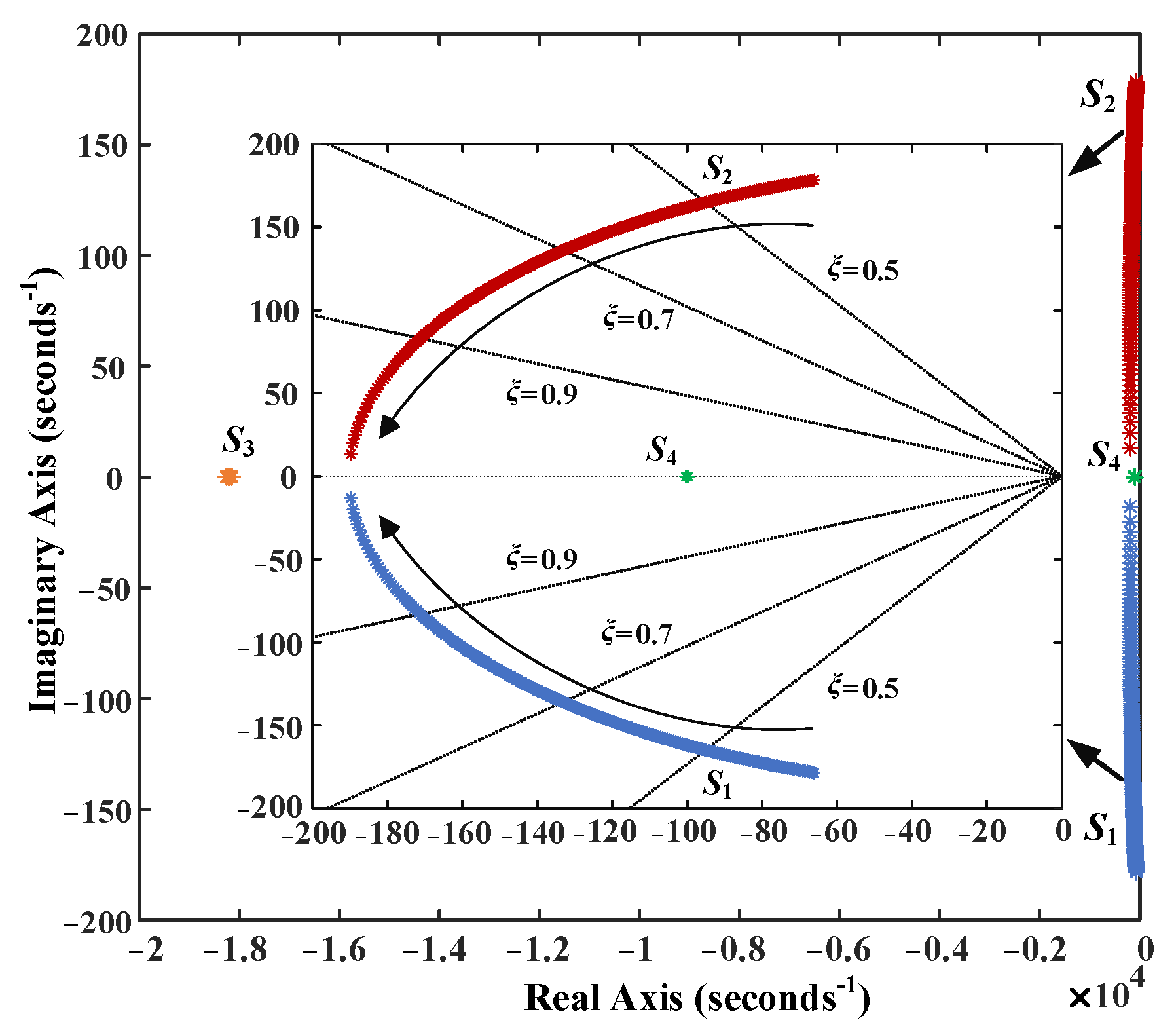
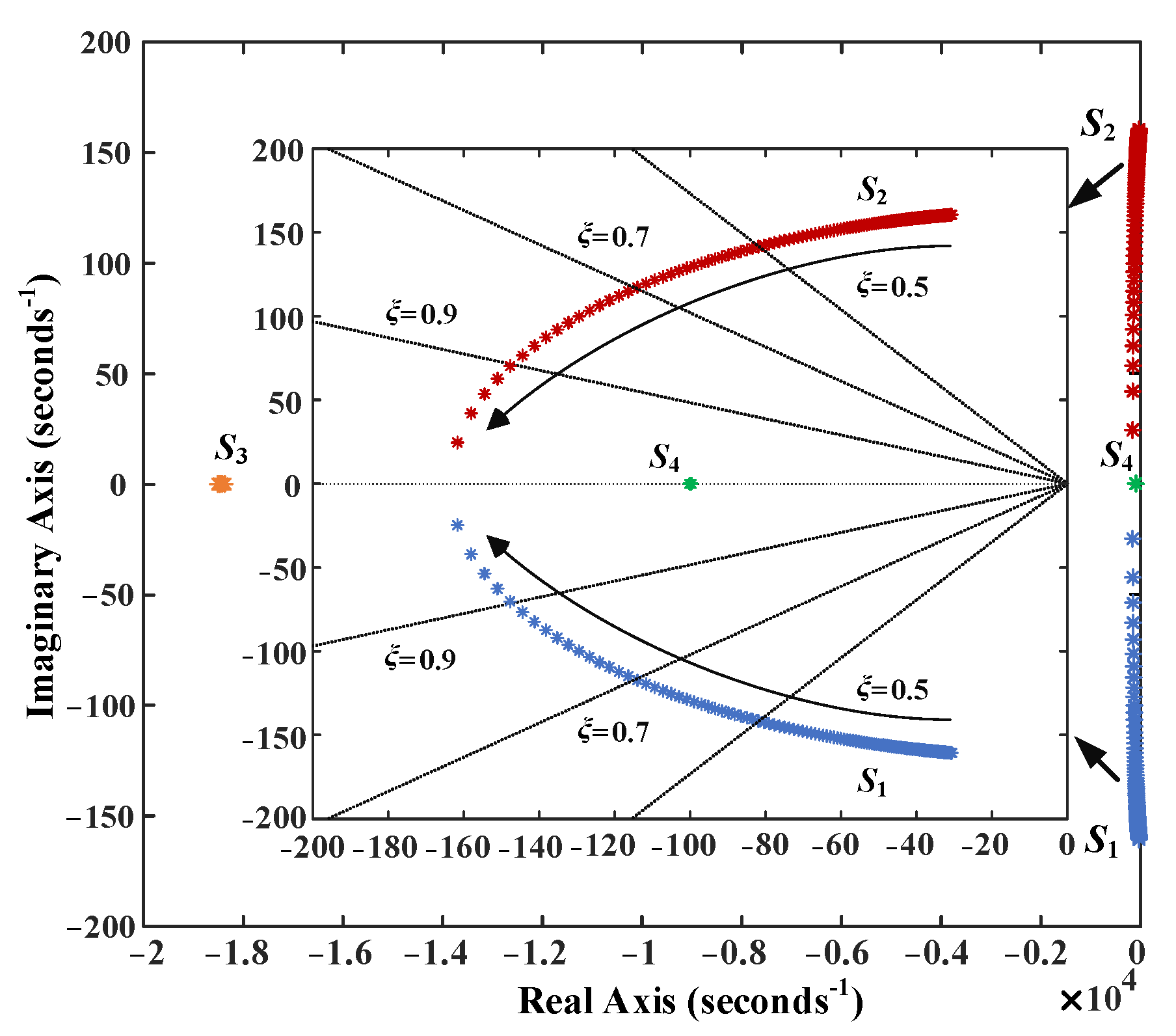



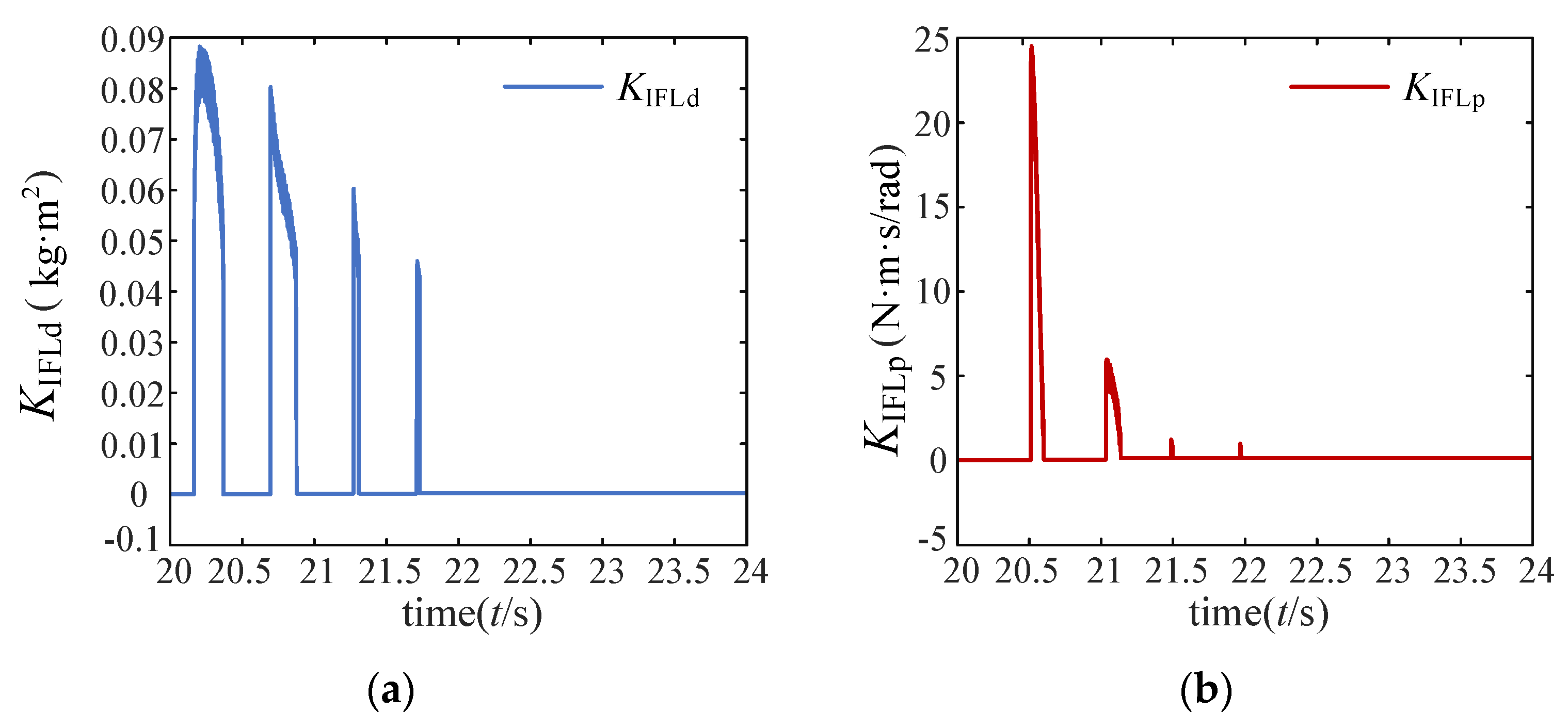

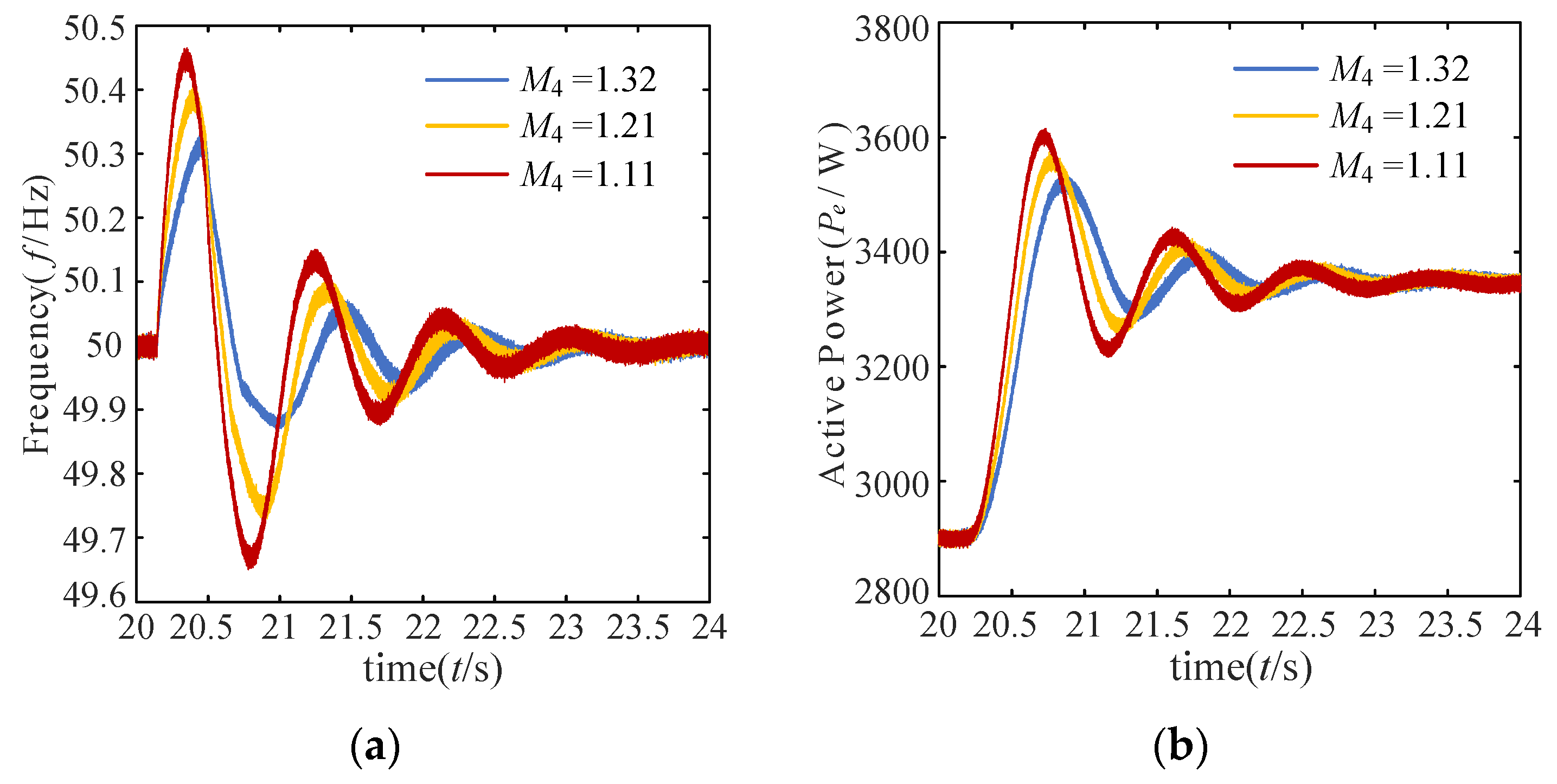

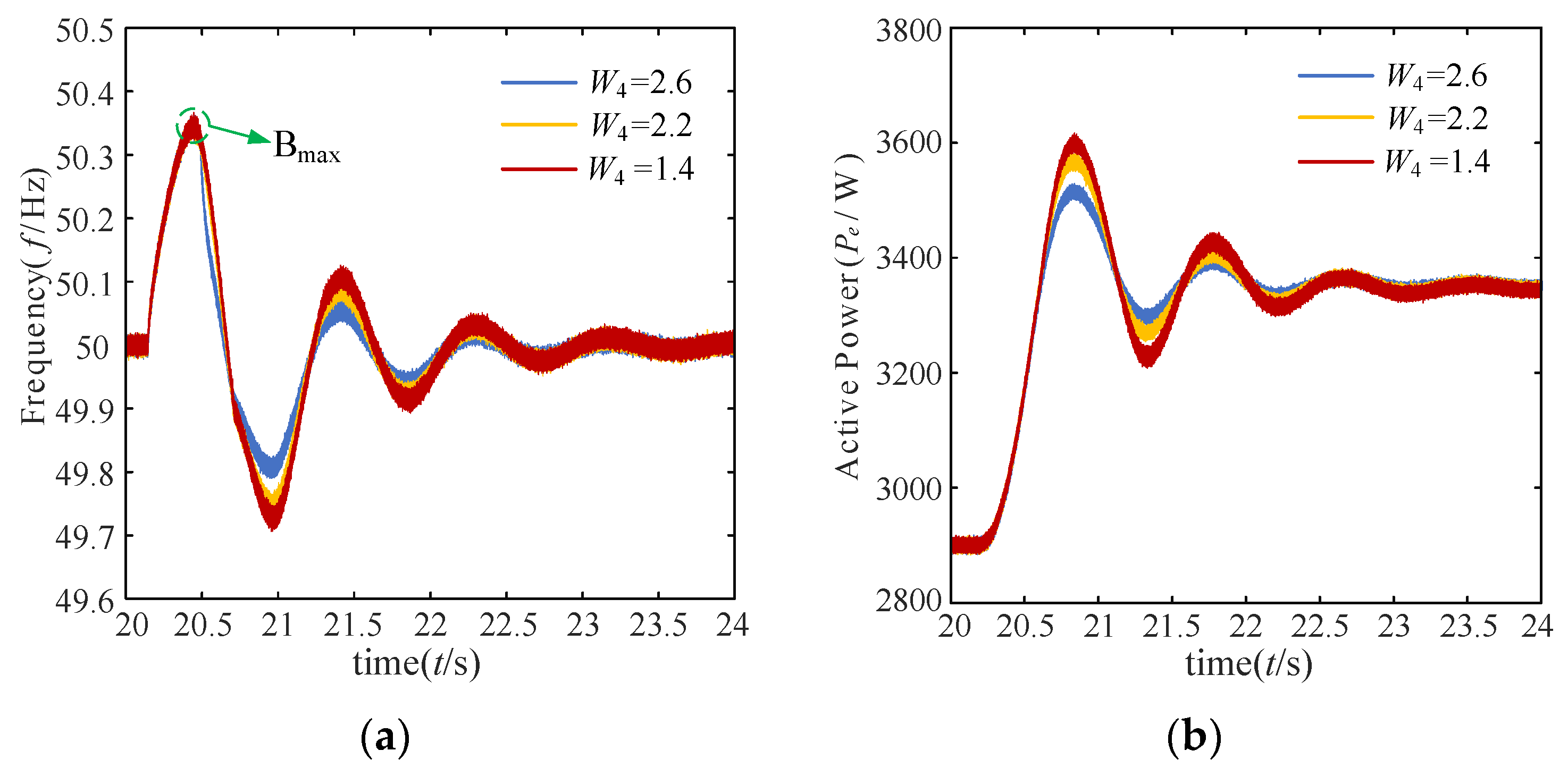
| Interval | Δω·dΔω/dt | KIFLd | KIFLp |
|---|---|---|---|
| 1 | >0 | increase | constant |
| 2 | <0 | constant | increase |
| 3 | >0 | increase | constant |
| 4 | <0 | constant | increase |
| Parameter | Value | Sensitivity Value |
|---|---|---|
| M2 | 0.018 | 77.5602 + 35.3369 j |
| M3 | 0.0035 | −31.9912 − 17.4572 j |
| M4 | 1.3 | −27.3342 + 25.5080 j |
| W2 | 9.1 | −87.9334 − 60.5238 j |
| W3 | 4.5 | 25.0369 + 22.8977 j |
| W4 | 2.5 | 28.3635 + 31.1124 j |
| KpQ | 0.001 | 3.5891 + 1.134 j |
| KiQ | 0.008 | −1.5480 + 1.3482 j |
| Rv | 0.01 | 4.7710 − 3.8901 j |
| Xv | 11.73 | 5.2377 + 6.0035 j |
| Ta | 0.01 | −0.387 + 0.040 j |
| Parameter | ts (s) | σ% |
|---|---|---|
| M3 = 0.0012 | 1.752 s | 7.462% |
| M3 = 0.0023 | 1.333 s | 6.268% |
| M3 = 0.0038 | 1.119 s | 4.776% |
| M4 = 1.11 | 1.763 s | 7.611% |
| M4 = 1.21 | 1.211 s | 6.119% |
| M4 = 1.32 | 1.103 s | 4.716% |
| W3 = 2.5 | 1.728 s | 7.223% |
| W3 = 3.9 | 1.408 s | 6.567% |
| W3 = 4.7 | 1.046 s | 4.239% |
| W4 = 1.4 | 1.812 s | 7.821% |
| W4 = 2.2 | 1.228 s | 6.238% |
| W4 = 2.6 | 1.121 s | 4.925% |
Publisher’s Note: MDPI stays neutral with regard to jurisdictional claims in published maps and institutional affiliations. |
© 2022 by the authors. Licensee MDPI, Basel, Switzerland. This article is an open access article distributed under the terms and conditions of the Creative Commons Attribution (CC BY) license (https://creativecommons.org/licenses/by/4.0/).
Share and Cite
Liu, Y.; Wang, H.; Wang, X.; Guo, G.; Jing, H. Control Strategy and Corresponding Parameter Analysis of a Virtual Synchronous Generator Considering Frequency Stability of Wind Power Grid-Connected System. Electronics 2022, 11, 2806. https://doi.org/10.3390/electronics11182806
Liu Y, Wang H, Wang X, Guo G, Jing H. Control Strategy and Corresponding Parameter Analysis of a Virtual Synchronous Generator Considering Frequency Stability of Wind Power Grid-Connected System. Electronics. 2022; 11(18):2806. https://doi.org/10.3390/electronics11182806
Chicago/Turabian StyleLiu, Yingming, Hanbo Wang, Xiaodong Wang, Guoxian Guo, and Hejun Jing. 2022. "Control Strategy and Corresponding Parameter Analysis of a Virtual Synchronous Generator Considering Frequency Stability of Wind Power Grid-Connected System" Electronics 11, no. 18: 2806. https://doi.org/10.3390/electronics11182806





